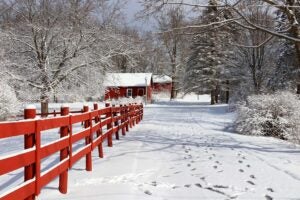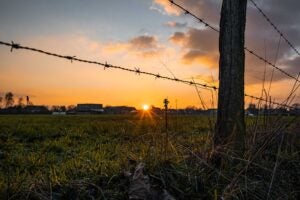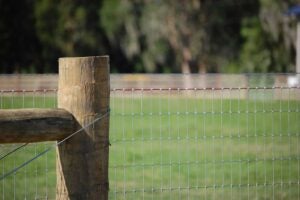The fencing market is not expected to slow down any time soon. A recent market analysis report suggests the market is expected to grow at a CAGR of 5.0 percent from 2022 to 2030, steeply rising from its 2021 valuation of $27.88 billion.
The steep growth of the fencing industry has been attributed to the increasing need for safety and security coupled with the higher reliability and lower maintenance costs of modern fencing solutions.
However, as much as fences are inexpensive to maintain, you can spend more on repairs or replacements because of biting weather elements.
Extreme weather, such as high summer heat and chilling cold over winter, can contribute to fast fence degradation. However, you can protect your fence against the elements by repainting, sealing, washing, and removing overgrown vegetation and rust.
Here’s what you need to know about how weather elements affect your fencing and how you can protect various fences from the elements.
The impact of different weather elements on your fencing
Apart from facing off with intruders, animals, insects, and humans and keeping your livestock contained, your fencing must also battle the weather elements for years and remain strong. These include rain, snow, hail, ice, and wind.
Fencing can suffer severely from the effects of weather elements. Not only can they compromise its structural soundness and swiftly deteriorate weaker fences, but they can also lessen your fence’s aesthetics.

Here’s the impact of some of the most common weather elements on your fencing:
Heat and cold
The temperature drops over winter make most fences less flexible and brittle. When the cold temperatures combine with high pressure, say from piled snow, the fence may break or crack.
During hot temperatures, especially over summer, most fences expand. If the fence isn’t flexible enough to allow for expansion or contraction, it may get damaged. Hot temperatures can also cause the fence to warp, leading to the boards pulling off their fasteners.
Sunlight
Ultraviolet (UV) rays from the sun can damage fences, often leading to discoloration or degradation. Wood fences are the most affected by UV damage. They easily fade when exposed to direct sunlight.
Modern vinyl fences counter the effect of UV rays from the sun using titanium dioxide (TIO2). Some finishes and stains also protect wood and vinyl fences from UV rays.
Moisture
Wood fences are highly susceptible to moisture damage. Moisture causes mildew, mold, or rot on wood fences, often leading to a soft-feeling fence. Any small holes or cracks on a wooden fence can cause moisture to permeate and destroy it.
Metal wire fences can also be susceptible to rust from moisture if not treated or galvanized. Vinyl and aluminum fences are less susceptible to moisture damage.
Snow and ice
Snow presents similar challenges as sleet, rain, and other forms of moisture. As the snow melts, most fences become susceptible to mold, rot, mildew, and rust.
Accumulated snow can also cause a lot of pressure on the fence, which can be problematic. Fences with large post caps or wide, flat surfaces can sag, warp, or crack under the amassed weight of the snow or ice. Therefore, robust fences fare better during winter months. You should regularly brush off large piles of snow or ice once they accumulate on the fence to adhere to best practices.
Hail
Apart from damaging roofs and cars, hail the size of a golf ball or softball can destroy fences. They often create unattractive marks, with wood fences being the most susceptible to such damage. Aluminum or wire fencing is hardly defaced by hail.
Wind
Moderate winds should not be a problem for most fences. However, strong winds can push a fence over, especially if it’s not structurally sound, made from sturdy material, and poorly installed. That’s why it’s often advised to hire fencing professionals to install your fence.

What can you do to protect your fence from weather elements?
Proper fence maintenance is a sure way of protecting your fence from weather extremes. Your process will typically vary depending on the fencing you have installed. Here’s the process for some of the most common fences.
Wood fences
Your wood fence should last 15 to 20 years with proper maintenance. However, the lifespan of your wood fence will depend on the type of wood it’s made from, the climate in your area, and the exposure of the fence to the elements.
Wood fences installed in areas with extreme weather conditions in shady spot that doesn’t get enough sunlight don’t have a long lifespan. Therefore, ensure your fence is made from durable wood and gets regular sunlight to prevent rot, mold, and mildew damage.
Wood fences also require more regular maintenance. It may start to split or warp if left unattended for a year. Typically, you have to do the following to take good care of your wood fence and protect it from weather elements:
- Seal the fence as soon as it’s built
- Inspect it once a month for damages such as loose nails, damaged pickets, and leaning posts
- Repaint every two to three years and re-stain every five to six years
- Kill mold or algae stains using a solution of 1 cup bleach and 1 gallon of water applied using a cloth or sponge
- Wash with a garden hose using soapy water to remove tough stains
- Wash with a pressure washer on a low setting for fences too large or too dirty to handwash
Vinyl fences
A vinyl fence is a relatively low-maintenance fence. It is free of most concerns that affect wood fences. It doesn’t rust or rot. If it’s not painted, it requires no repainting. It also doesn’t warp or fade and offers a very durable structure. However, it is not as strong as wire fencing. Also, surface dirt and stains can make it look dingy and old over time.
Most vinyl fences only require cleaning. A garden hose with a sponge and soapy water is often adequate to remove dirt and stains. If you’re dealing with live stains, such as mold and algae, a diluted solution of chlorine bleach and water or white vinegar, water, and elbow grease will kill the algae and remove the stains.
Metal and wire fences
Metal and wire fences are the most durable and robust fencing solutions. Most installations can be found in residential, commercial, and agricultural areas. A metal or wire fence can last 20 to 30 years, with some installations lasting 50 to 60 years. Moreover, metal fences can aesthetically mimic the looks of wrought iron without the high cost.

Metal fences are low maintenance. Typically, you should perform an inspection once a year to gauge any problems with the fence and stop any problems before they loosen or develop rust or worse. The inspection should also help identify scratches, chips in the sealant, dents, missing caps or links, and other issues that may damage the metal.
You should also regularly wash your metal fence to extend its lifespan and wax it when necessary. Cleaning helps remove dust, debris, dead bugs, and salt from the rain. Make sure you don’t use acids such as vinegar on the fence. They break down the sealant and trigger rust development.
Also, ensure you’re using galvanized metal wire fences that last longer. Galvanization significantly reduces the development of rust.
Benefits of keeping up with your fence maintenance
Carrying out proper and regular fence maintenance carries the following benefits:
- Saves money: Fence repairs can be expensive, especially if the damage is irreparable.
- Helps avoid replacement: Regular maintenance ensures your fence is in top condition, with only minimal repairs needed.
- Keeps your fence looking great: Proper fence maintenance ensures your fence maintains great aesthetics over the long term.
Rely on a robust fencing solution
Fences need regular maintenance to stay in top-notch condition, especially considering the impact weather can have all year round. Therefore, you need to install a robust fencing solution. Get in touch with a reputable supplier and installer to ensure you’re getting a fence that will weather the weather.
This article was published on behalf of Red Brand.
Dain Rakestraw is the Director of Marketing and Client Services at Red Brand, a line of premium agricultural fencing products known as the most recognized brand of agricultural fencing in the United States. Since 1889 Red Brand has provided the market with a range of popular products, including field fence, horse fence, barbed wire, welded wire, tools and more.


